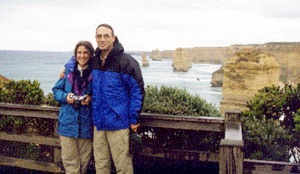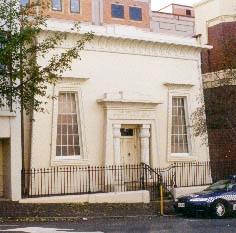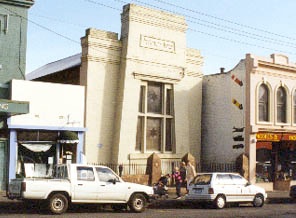Melbourne, Canberra, and other views of Australia
From Tasmania we flew to Melbourne where we stayed in a quiet and beautiful area of the city (East Melbourne), somewhat reminiscent of Savannah or Charleston, with town homes having front verandas. A short walk took us through a park and into the heart of the city. We visited the Victorian (Melbourne is in the state of Victoria, hence "Victorian") Parliament, which is housed in a grand old building, and observed sessions of both houses. We also attended the Supreme Court, which is the regular trial court for Victoria, and saw parts of two murder trials: one for the charging of the jury (the defendant had offered no defense to counter the state's charges) and the other for a sentencing hearing (for a woman found guilty of taking out a successful contract on the life of her husband--the judge was perplexed by this case since she gained no money by his death and had not claimed abuse by the man). It was fun to see the wigs and gowns on the judge and barristers, and yet the court routine is very similar to that in the U.S.
On Saturday, May 29, a mostly cloudy, rainy day, we took a private tour of the Great Ocean Road, southwest from Melbourne. It was a long drive with stops at various lookouts. This isn't our preferred way of touring and it was rather grueling; we'd have preferred to see a smaller area and to have hiked. The drive back to Melbourne was more than 2 hours, but made interesting by the political and historical commentary our driver gave us as we queried him.
The next day we drove north out of Melbourne into flat, nondescript countryside. It seemed to Dan that we were driving on an endless tape consisting of a straight two-lane road lined with eucalyptus trees with sheep beyond in the fields. To vary the scenery, we went underground in the town of Bendigo to tour an operating gold mine. Gold was an important part of Australia's history and there's been a reopening of some of the mines, though the falling price of gold may shut them down again. We continued the boring drive and stayed in Echuca, a town on the Murray River. The next day we drove to Albury, stopping en route in the Rutherglen area to visit some wineries and a cheese factory.
We then went to Canberra. Designed by an American, it's definitely not pedestrian-friendly; however, we did walk around most of it. We attended the Question Time in the House of Representatives (a rollicking session concerning the proposed GST-General Sales Tax), toured the Parliament and High Court buildings (they're stunning), went to the National Art Gallery and the National Library (there saw a very good exhibit on Australian birds), walked in the embassy and residential neighborhoods.
About half and hour hour from Canberra in a rural, hilly area is the Avalanche Homestead, a sheep and cattle farm. We were the only guests the following night and were treated to a lesson in sheep shearing, views of kangaroos, wombats, enormous termite hills, excellent vistas, and fine food and conversation from the well-traveled couple who run the place.
The last day when we returned to Sydney, we had just enough time to visit one more museum which houses one of the best collections of Aboriginal artifacts in Australia. We ate our last dinner at a fine restaurant on the wharf overlooking the Opera House and the Harbor Bridge.
Hobart Synagogue
Throughout our travels, we visited (that is, saw the exterior--all were locked with chained gates) the oldest synagogues in Australia. These are in Hobart and Launceston, Tasmania and are architecturally similar, looking rather Egyptian. There are also large, grander synagogues in Sydney and Melbourne, and Canberra has a more modern Jewish Center.




Launceston Synagogue
Australia is more like the United States than I had imagined. There are fewer people, but the ratio of cell phones to people is higher, perhaps the highest of any country in the world. Many of our national chains (among them: McDonald's, Kentucky Fried Chicken, K-Mart, Target) have made inroads into the Australian market, though it is still possible to find independent stores with unique Australian products. I bought a Driza Bone riding coat; made of oiled cloth, it will serve well as a raincoat in the fall and winter. A Tasmanian specialty is waterproof, leather slip-on boots, Blundstones or "Blunnies." Joshua had a pair which he liked, so I bought a pair, just in time, since I wore them on a wet day and then again on the farm.
The food in Australia was outstanding. Since World War II, the country has become multi-cultural and we were able to eat a different ethnic cuisine nearly every night, even in the outlying towns. The produce is fresh; salads and fruit are always plentiful. The Australians are by and large a very friendly people, but there are definitely more sheep than people!
The Australian terrain is varied, especially in Tasmania, going from lush forest and unspoiled beaches to rolling countryside with lots of sheep to jagged mountains. We didn't see the northern part of the country with the tropical rain forest nor did we see the outback. Perhaps on another trip!

